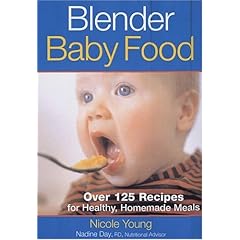 So you now know that Adelaide (the youngest member of the collective) is totally into pickles. I don't know that I would've let Josie love pickles as one of her first handful of foods (thanks to my maternally overprotective instinct), but daddio and I have encouraged our kids try a wide variety of strange and unexpected foods and have made nearly all of their 'baby food' (that is, the purees, snacks, and chopped up stuff that they eat for the first six months or so). So far it's really worked! We have a couple of kids who will eat just about anything (Josie avoids spicy things, Jasper's not really into meat, and we all dislike avocados, but everything else is fair game). Thank goodness, since I was such a picky eater. I don't quite know how my mother put up with it!
So you now know that Adelaide (the youngest member of the collective) is totally into pickles. I don't know that I would've let Josie love pickles as one of her first handful of foods (thanks to my maternally overprotective instinct), but daddio and I have encouraged our kids try a wide variety of strange and unexpected foods and have made nearly all of their 'baby food' (that is, the purees, snacks, and chopped up stuff that they eat for the first six months or so). So far it's really worked! We have a couple of kids who will eat just about anything (Josie avoids spicy things, Jasper's not really into meat, and we all dislike avocados, but everything else is fair game). Thank goodness, since I was such a picky eater. I don't quite know how my mother put up with it! Fundamental to our strategy to make our children the type who will eat anything was the 'making our own baby food' part, plus introducing them to bits of table food as early as possible (which is why Adelaide was enjoying bits of watermelon and sucking on a celery stalk yesterday). I would have to say that it has been a pretty easy addition to what we already do, and that it has saved us tons of cash in the process. You don't need much to start the process, and even if you're only making some of your kid's food you'll still be saving money, producing less waste, and feeding your baby foods that taste like real food....setting them up to love real food later!
So what do you need to get started?
1: A blender, food mill, baby food grinder, or food processor. When I'm churning out batches of baby food to freeze I prefer the blender, but as they get a bit older and I'm processing a bit of what we're having for dinner or grinding batches of chunky food like chicken pot pie I like the mini food processor or baby food grinder. Nothing special here, and I'll bet you've already got one of these in your kitchen.
2: Ice cube trays and zip-top freezer bags. Once you blenderize the food with a bit of water or breastmilk, just pour it into ice cube trays and freeze it until solid, then turn it out into freezer bags for long-term storage. I have a stash of trays that I picked up at the thrift store for about $1 for six.
3: Food. You can use fresh or frozen fruits and vegetables, regular full-fat yogurt, jarred nut butters (e.g. cashew and almond), or even what you've made for dinner. We don't really limit seasonings, but I generally don't add salt or butter, etc, to simple purees.
Seriously, that's it. I can buy a big bag of organic frozen peas, cook, puree, and freeze about 12 servings in ten minutes (and empty the dishwasher while the peas cook). I know what's in the food and that it tastes fresh and like sweet garden peas rather than pale, mushy canned peas. All told, it costs about ten to fifteen cents per serving with no jar or container to throw out.
This is really a simple guide to get you started. To really get the job done I've relied on two books to supply guidelines about what foods should be fed at what ages (e.g. no yogurt until 9 months, no corn until a year, etc) and how to process certain foods (you have to cook some foods but not others, must be careful peeling mangos, etc), and recipes to combine foods and make my own cereals. I've looked at a lot of choices and own several, but these are my go-to guides:
Super Baby Food
 Blender Baby Food
Blender Baby FoodFinally, since I've somehow been blessed with kids who will eat anything, I keep running out of ideas. Seriously, I'd love to fall back on chicken nuggets and mac and cheese sometimes, but they want to eat! So I picked up Toddler Café: Fast, Healthy, and Fun Ways to Feed Even the Pickiest Eater













